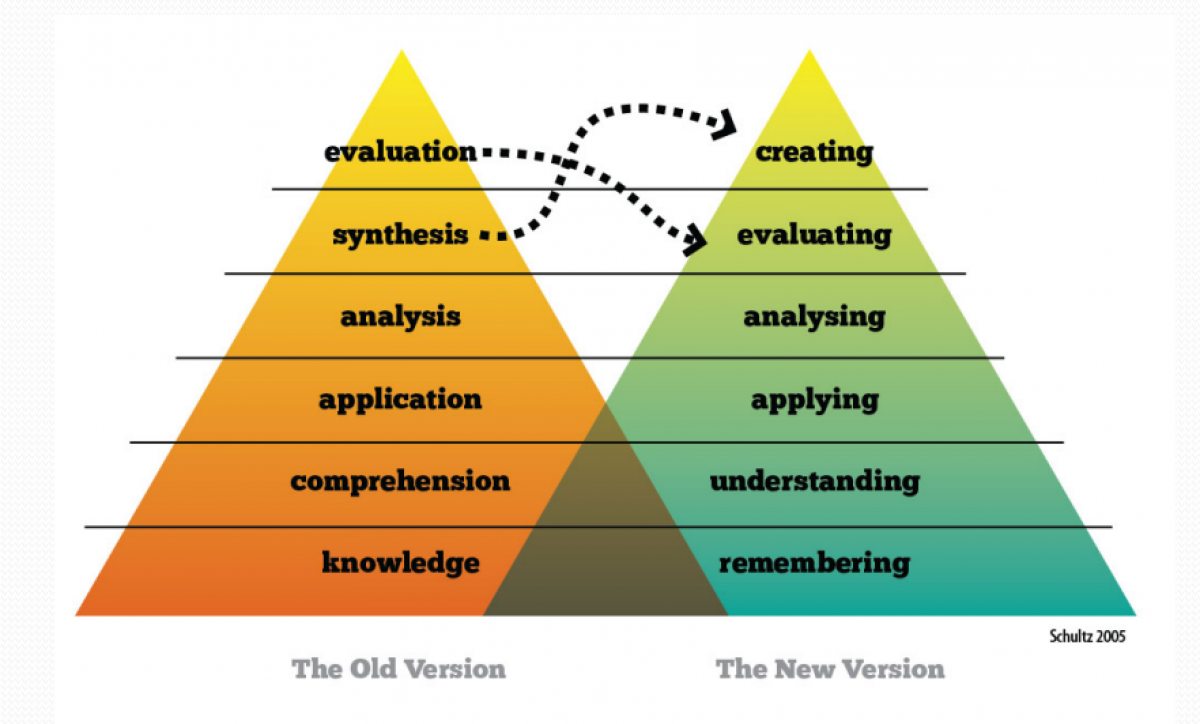Bloom's taxonomy, or the set of three hierarchical models to classify educational learning objectives into levels of complexity and specificity. We will have a closer look at what Bloom's taxonomy is, how many levels it consisted of in the original model and what the key verbs are in the revised version of the model. Finally, we will briefly explore the implementation of Bloom's taxonomy in the digital era.
The original taxonomy
Before we dive into Bloom's taxonomy, we must first understand what the word "taxonomy" means. Taxonomy is the branch of science concerned with classification. It is also used as a way of ordering, hierarchizing, and labeling something, especially organisms, although nowadays it is used in many fields, including education.
The word "Bloom" comes from Benjamin Bloom, an American psychologist, and pedagogue who, in the late 1950s, conducted a series of studies related to the learning process. Considered a pioneer of the field, Bloom suggested a structured approach to educational models.
Therefore, Bloom's taxonomy is an educational model used to classify educational learning objectives that has been employed for various decades. For Bloom, learning occurs in three different areas divided into domains; each domain being acquired after the mastery of the previous one - the cognitive domain, the affective domain, and the psychomotor domain.
In other words, Bloom's taxonomy offers an answer to the question: "How do we consolidate and apply our knowledge?". Considering it provides a step-by-step approach, this model has become a useful tool for educators worldwide.
Bloom's Taxonomy: Levels and domains
Bloom's taxonomy explains that to apply knowledge (in a behavior), we need to have previously generated that knowledge via understanding concepts. To understand them, we must first remember, organize, and synthesize them. Bloom called this process the Cognitive domain, considering that we deal with processing information and practicing mental abilities.
His original taxonomy described and organized six of these abilities which he called levels, seeing how they occur in a sequence: know, understand, apply, analyze, synthesize, and finally evaluate. This, however, represented only one of the three domains that Bloom spoke about. The other ones are the Affective domain and the Psychomotor domain. The affective domain is responsible for the behaviors, and emotions needed to complete the learning process, and it is made up of five levels:
- Receiving - being aware of or sensitive to the existence of certain ideas
- Responding - actively responding to ideas
- Valuing - perceived by others as valuing certain ideas
- Organization - is to relate the value to those already held and reach consensus
- Characterization - to act consistently by the values he or she has internalized
Finally, Bloom introduced the psychomotor domain which relates to physical movement, coordination, and use of the motor-skill areas that enable learning. The stages of this domain are:
- Perception - the ability to use sensory cues to guide motor activity
- Set - readiness to act
- Guided response - early stages in learning a complex skill that includes imitation and trial and error
- Mechanism - learned responses have become habitual and the movements can be performed with some confidence
- Complex overt response - skillful performance of motor acts that involve complex movement patterns
- Adaptation - skills are well developed, and the individual can modify movement patterns
- Origination - creating new movement patterns to fit a particular situation o
In education, these levels were subsequently translated into specific learning objectives and were used as guidelines in the teaching process.
Critiques
Bloom's taxonomy was developed in the late 1950s, in a time when behaviorism was the leading educational theory and cognitive science was making crucial breakthroughs. One of the most significant critiques made to Bloom's model is that it lacks many scientific discoveries that relate to learning. For example, the idea that our memory is not a storing device that acts in a single way (we have different types of memory), or that it does not accurately represent the way that we learn things.
The reality is, we don't initially remember things, then understand them, then apply them, and then go up the pyramid as our capacity increases. Instead, much of the time we achieve understanding by applying knowledge and by creating things. Bloom's taxonomy has also been criticized because it fails to take into account contemporary social dynamics that have drastically changed the way we learn (e.g., ICT - Information and Communications Technology). All of these factors contributed to the fact that many specialists didn't regard Bloom's taxonomy as a viable learning theory which prompted its revision in 2001.

Bloom's taxonomy verbs - Revised edition
The primary revision done to Bloom's taxonomy was conducted between the 1990s and 2000s by a few of Bloom's students. One of the critical changes has been to replace the nouns used to denominate learning objectives or the levels of the teaching/learning process with verbs. This will allow for more clarity regarding the actions that need to be conducted.
The order of the levels has also been changed, and we now have six categories, or levels, each with key verbs that are also used as objectives in educational schemes as follows: remember, understand, apply, analyze, evaluate, create.
LOTS and HOTS
In ascending order, the verbs that indicate the levels are: remember, understand, apply, analyze, evaluate, and create. At the bottom of the scale, we have the Lower Order Thinking Skills also known as LOTS. These include key verbs like recognize (indicative of remember), paraphrase (indicative of understand), use (indicative of apply), compare (indicative of analyze), experiment (indicative of evaluate), and design (indicative of create).
At the top of the scale, we have the Higher Order Thinking Skills also known as HOTS. This model, however, was lacking in the area of digital changes. For this reason, Bloom's taxonomy was revised once again and new key verbs are now used as objectives in the digital era.
Synonyms of the most important verbs
One of the elements that stand out in Bloom's taxonomy is the key verbs that can also function as synonyms of the primary ability. Knowing these terms allows us to widen the range of abilities deployed in teaching schemes. We will have a look at the principal synonyms for HOTS and LOTS:
Synonym of remember: list, describe, identify, retrieve, locate, label
Synonym of understand: exemplify, paraphrase, infer, summarise, compare, classify, interpret
Synonym of apply: implement, execute, use, develop
Synonym of analyze: survey, consider, distinguish, differentiate, subdivide
Synonym of evaluate: appraise, argue, defend, judge, select, value
Synonym of create: design, construct, develop, formulate, author, investigate

Bloom's digital taxonomy verbs
The revision of Bloom's taxonomy to account for the new behaviors, actions and learning opportunities emerging as technology advances, consists of key verbs for each of the abilities presented in the Lower and the Higher Order. The key verbs, or objectives, are directly linked to the abilities one hopes to acquire about using technology and social media. Listed in ascending order, the verbs are as follows:
Remember: bullet pointing, highlighting, bookmarking or favoriting, social networking, searching or “googling.”
Understand: advanced searches, boolean searches, blog journaling, twittering, categorizing and tagging, commenting, annotating, subscribing
Apply: implementing, carrying out, using, executing, running, loading, playing, operating, hacking, uploading, sharing, editing
Analyze: comparing, organizing, deconstructing, attributing, outlining, finding, structuring, integrating, mashing, linking, reverse-engineering, cracking and mind-mapping
Evaluate: blog/vlog commenting, reviewing, posting, moderating, collaborating, networking, reflecting, alpha & beta testing, validating
Create: programming, filming, animating, blogging, video blogging, mixing, remixing, wiki-ing, publishing, videocasting, podcasting, directing/producing, building or compiling mash-ups
Finally, as part of the learning process in the digital era, Bloom's taxonomy recognizes 17 more verbs that are connected to the communication spectrum: collaborating, moderating, negotiating, debating, commenting, skyping/video conferencing, reviewing, questioning, replying, posting and blogging, networking, contributing, chatting, e-mailing, twittering, instant messaging, texting.
- This article about "Bloom's Taxonomy" was originally published in Spanish in Viviendo La Salud
References:
Bloom, B., et al. (1971) Taxonomía de los objetivos de la educación: la clasificación de las metas educacionales : manuales I y II.Traducción de Marcelo Pérez Rivas; prólogo del Profesor Antonio F. Salonía. Buenos Aires: Centro Regional de Ayuda Técnica.
Churches, A. (2009). Taxonomía de Bloom para la Era Digital. Available at http://uvsfajardo.sld.cu/sites/uvsfajardo.sld.cu/files/taxonomia_de_bloom_para_la_era_digital.pdf
What is the Affective Domain anyway? https://serc.carleton.edu/NAGTWorkshops/affective/intro.html
